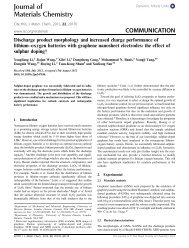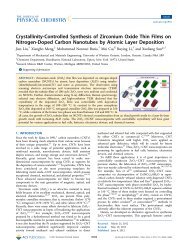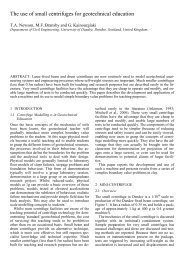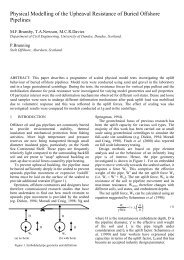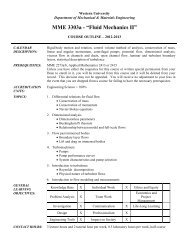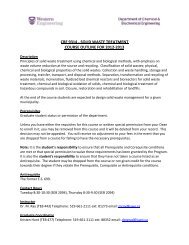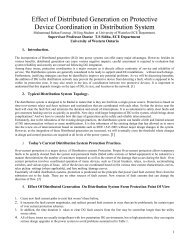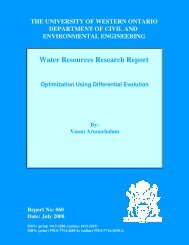Journal of Colloid and Interface Science - Western Engineering ...
Journal of Colloid and Interface Science - Western Engineering ...
Journal of Colloid and Interface Science - Western Engineering ...
Create successful ePaper yourself
Turn your PDF publications into a flip-book with our unique Google optimized e-Paper software.
126 Y. Li et al. / <strong>Journal</strong> <strong>of</strong> <strong>Colloid</strong> <strong>and</strong> <strong>Interface</strong> <strong>Science</strong> 369 (2012) 123–128<br />
Fig. 4. FT-IR spectra (A) <strong>and</strong> Raman scattering spectra (B) <strong>of</strong> the products prepared at (a) 100 °C <strong>and</strong> (b) 140 °C in 25 min.<br />
the vibration due to the interaction <strong>of</strong> Mn with surrounding species,<br />
such as OH, O, H + , <strong>and</strong> K + . The water molecules or cations<br />
intercalated into the MnO 2 interlayer or tunnels were introduced<br />
during the synthesis to build/maintain the structures [35]. It has<br />
been reported that in hydrous MnO 2 samples, the peaks appear<br />
at 1620 <strong>and</strong> 1280 cm 1 [36]. The high frequency shift in our case<br />
reveals the strongly bonded nature [37]. The FT-IR spectra results<br />
in the region <strong>of</strong> 800–400 cm 1 reveal information about MnO6<br />
octahedra (inset in Fig. 4A). A major difference between the two<br />
kinds <strong>of</strong> samples has been witnessed in this region. For birnessite-type<br />
MnO 2, a broadb<strong>and</strong> is present at 514 cm 1 while four<br />
weak b<strong>and</strong>s are recorded at 668, 456, 434 <strong>and</strong> 416 cm 1 , respectively.<br />
The results are different from that <strong>of</strong> literatures, viz. the<br />
b<strong>and</strong> at 635, 583, 513, 477, <strong>and</strong> 423 cm 1 , respectively [38]. Especially,<br />
the b<strong>and</strong> at 423 cm 1 indicates the crystalline order <strong>of</strong> the<br />
birnessite compound [34]. The distortion <strong>of</strong> MnO6 octahedra is<br />
due to the constitutional water in the sample [37]. Obvious differences<br />
can be observed for a-MnO2. Two dominant b<strong>and</strong>s at 524<br />
<strong>and</strong> 466 cm 1 <strong>and</strong> five weak b<strong>and</strong>s at 720, 668, 636, 431, <strong>and</strong><br />
416 cm 1 are recorded, which are similar to those previously<br />
reported for a-MnO 2 materials [39].<br />
Fig. 4B shows the Raman spectra <strong>of</strong> birnessite-type <strong>and</strong><br />
a-MnO 2. Three main contributions at 506, 565, <strong>and</strong> 648 cm 1 are<br />
detected for the birnessite-type MnO2. The Raman b<strong>and</strong> at<br />
648 cm 1 can be viewed as the symmetric m2(Mn–O) stretching<br />
vibration <strong>of</strong> MnO6 groups, <strong>and</strong> the b<strong>and</strong> at 565 cm 1 is attributed<br />
to the m3(Mn–O) stretching vibration in the basal plane <strong>of</strong> MnO6<br />
sheets [40]. The m3(Mn–O) stretching frequency presents a shift<br />
<strong>of</strong> 10 cm 1 toward the low-frequency side, which is attributed to<br />
the defect chemistry <strong>and</strong> the local disorder <strong>of</strong> the as-prepared<br />
birnessite structure [34]. The Raman spectrum <strong>of</strong> a-MnO2 nanotubes<br />
has several contributions at 180, 380, 483, 570, <strong>and</strong><br />
635 cm 1 . The low-frequency Raman b<strong>and</strong> at 180 cm 1 is assigned<br />
to an external vibration that due to the translational motion <strong>of</strong> the<br />
MnO6 octahedra, while the Raman b<strong>and</strong> at 380 cm 1 is caused by<br />
the Mn–O bending vibrations. It is emphasized that the relative<br />
intensities <strong>of</strong> two high-frequency Raman b<strong>and</strong>s at 570 <strong>and</strong><br />
635 cm 1 are correlated to the nature <strong>of</strong> the tunnel species [39].<br />
Hence, the spectrum reflects the good crystallinity <strong>of</strong> the<br />
a-MnO 2, which is in agreement with the structural studies reported<br />
above.<br />
3.2. Growth mechanisms <strong>of</strong> MnO2 nanostructures<br />
The formation mechanism <strong>of</strong> the flower-like MnO2 microspheres<br />
has been widely accepted in the previous report for hydro-<br />
thermal method [41]. We believe that the microwave-assisted<br />
hydrothermal method has a similar mechanism. In brief, firstly,<br />
large amount <strong>of</strong> nuclei form rapidly in a short time <strong>and</strong> then<br />
self-assembly to form amorphous spheres. During the hydrothermal<br />
process, an Ostwald ripening process is carried out, in which<br />
smaller particles dissolve while the bigger ones grow into sheetlike<br />
particles with a lamellar structure. Finally, the sheet-like particles<br />
tend to curl <strong>and</strong> assembly to form a core-corona hierarchical<br />
structure.<br />
By contrast, several models have been suggested in terms <strong>of</strong> the<br />
formation <strong>of</strong> metal or metal oxide nanotubes in a solution-based<br />
process. Ye et al. proposed a curving followed by seaming <strong>of</strong><br />
molecular layers mechanism for the tube-formation process <strong>of</strong><br />
materials with layered structure [42]. Mo et al. suggested a template-roll-growth<br />
<strong>and</strong> template-twist-join-growth mechanism for<br />
the formation <strong>of</strong> Te nanotubes [43]. Wang <strong>and</strong> Li proposed a rolling<br />
mechanism for the conversion from MnO 2 nanosheets to nanotubes<br />
[28]. Luo et al. proposed a tip-/end-etching process for the formation<br />
<strong>of</strong> MnO 2 nanotubes [44]. However, no evidence is shown to support<br />
these hypotheses in our system.<br />
The reaction in our process could be described as follows:<br />
Half reaction:<br />
2Cl ! Cl2 þ 2e ðE 0 ¼ 1:3595 VÞ<br />
MnO 4 þ 4H þ þ 3e ! MnO2 þ 2H2O ðE 0 ¼þ1:695 VÞ<br />
Overall reaction:<br />
2MnO 4 þ 8H þ þ 6Cl () 2MnO2 þ 3Cl2 þ 4H2O<br />
To underst<strong>and</strong> the formation <strong>of</strong> the a-MnO2 nanotubes, the<br />
reaction under different periods <strong>of</strong> time was investigated. Fig. 5<br />
shows the TEM images <strong>of</strong> three samples taken at different stages<br />
<strong>of</strong> the reaction. When the reaction proceeded for 5 min, some<br />
microspheres with core-corona architecture were produced with<br />
a diameter about 1 lm, <strong>and</strong> the thickness <strong>of</strong> nanosheets is about<br />
10 nm (Fig. 5a). After 10 min, the microspheres tended to collapse<br />
<strong>and</strong> some fibrous structures formed. From Fig. 5b, it can be seen<br />
that three different types <strong>of</strong> fibrous structures formed: nanorod<br />
with a diameter about 20 nm (Fig. 5d); bundle-like tube with a<br />
diameter about 50 nm (Fig. 5e); <strong>and</strong> nanotube with a diameter<br />
about 80 nm (Fig. 5f). As shown in Fig. 5e, the bundle-like tube consists<br />
<strong>of</strong> nanorods about 16 nm in diameter, which is consistent to<br />
the diameter <strong>of</strong> the single nanorod in Fig. 5d. Fig. 5f shows that<br />
the nanotube has smooth surface but an uneven end, <strong>and</strong> the wall





